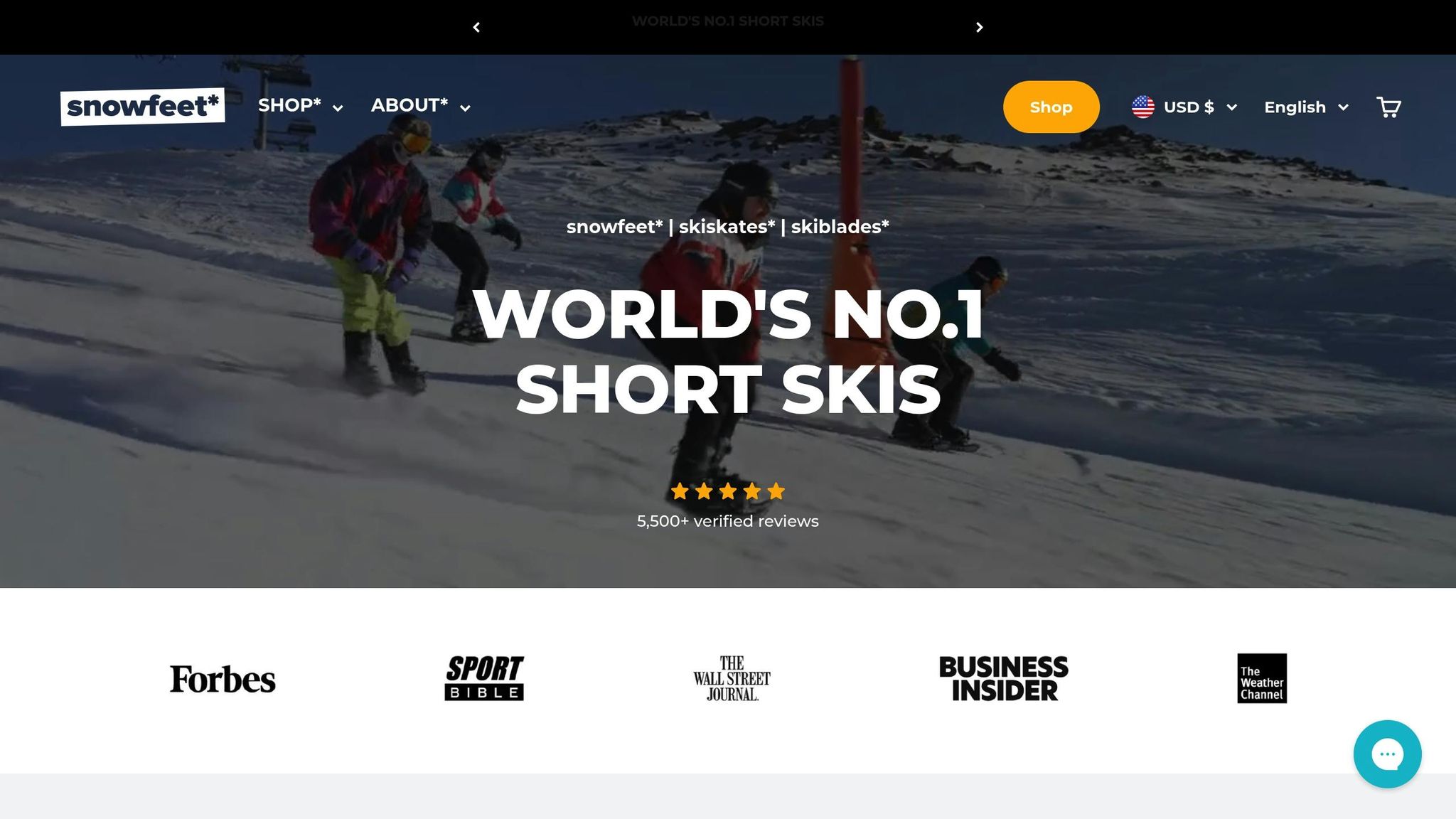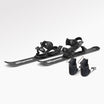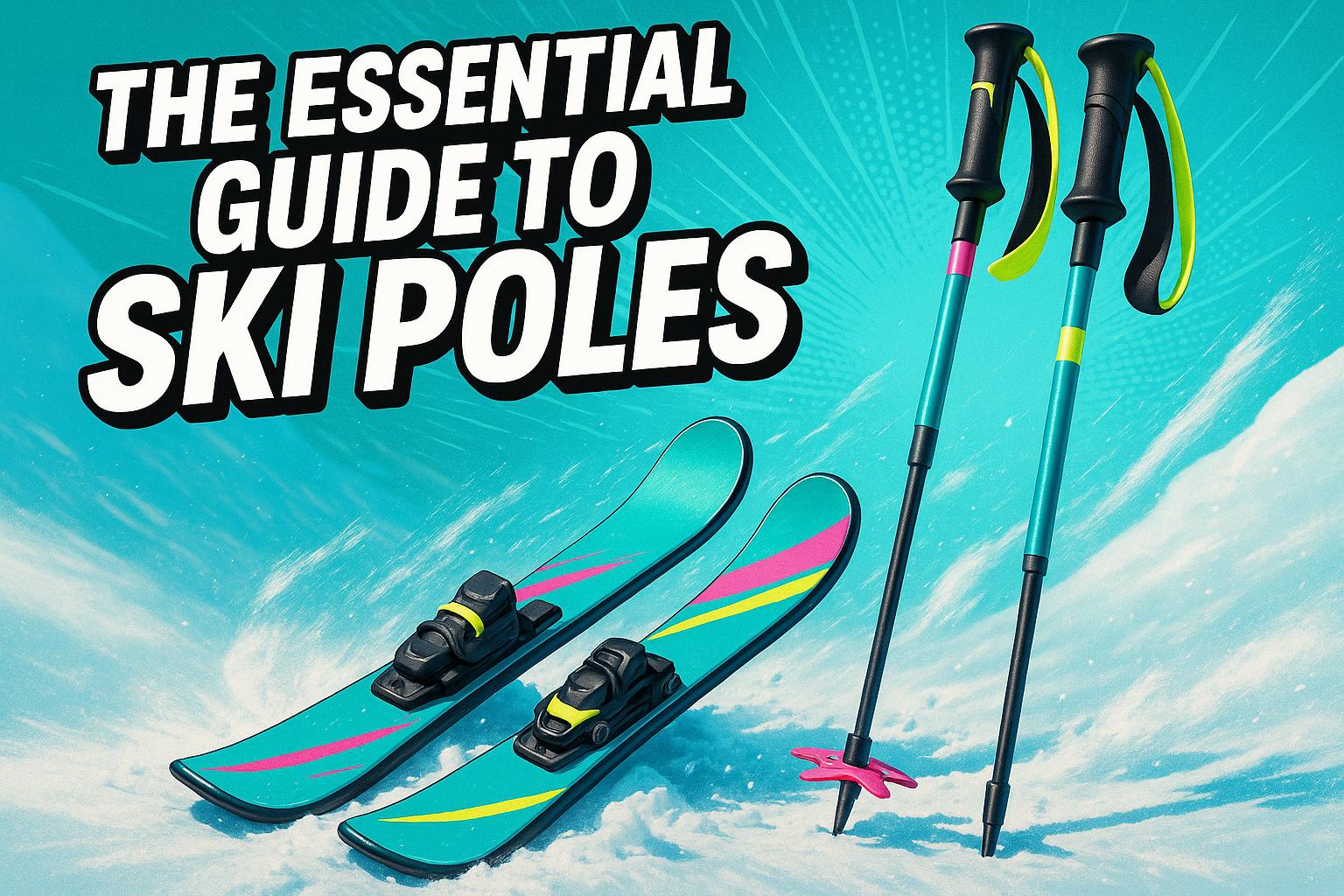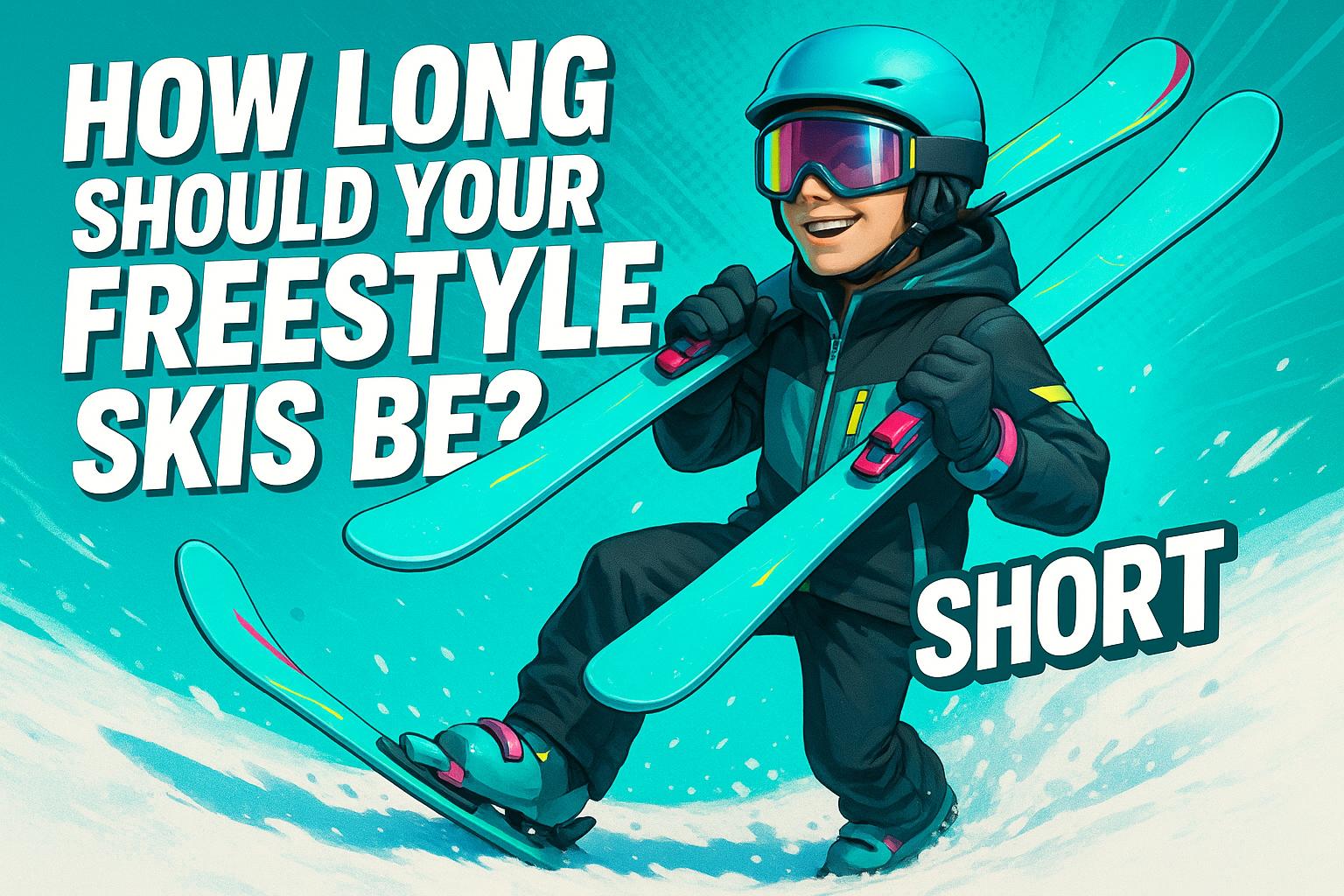Elegir la longitud correcta del esquí es clave para disfrutar tu tiempo en la montaña. Si son demasiado largos, sentirás que estás luchando con un animal salvaje. Si son demasiado cortos, perderás estabilidad cuando más la necesitas. Aquí está la cuestión: la longitud del esquí no es talla única. Depende de tu altura, peso, nivel de habilidad e incluso del terreno que planeas enfrentar.
Puntos clave:
- Los esquís más largos ofrecen velocidad y estabilidad, pero son más difíciles de controlar, especialmente para principiantes.
- Los esquís más cortos son más fáciles de girar y geniales para aprender, pero pueden sentirse inestables a altas velocidades.
- Snowfeet esquís cortos y Skiskates (38–120 cm) son un cambio total para el control, la portabilidad y la diversión.
¿Quieres evitar errores comunes y encontrar el ajuste perfecto? Ya seas principiante o profesional experimentado, esta guía desglosa todo lo que necesitas saber para elegir la longitud correcta del esquí y aprovechar al máximo tu equipo.
¿Qué tan largos deberían ser mis esquís?
Error Común en la Longitud del Esquí
Elegir la longitud correcta del esquí es un cambio radical para la estabilidad y el control en las pistas. Pero un error común puede arruinar toda tu experiencia de esquí: optar por esquís demasiado cortos.
Error: Elegir Esquís Demasiado Cortos
Los esquís cortos pueden parecer más fáciles de manejar al principio, pero tienen sus desventajas. Les falta la estabilidad que necesitas, especialmente cuando vas a altas velocidades. Además, pueden ser más difíciles de controlar cuando el clima se pone difícil o las condiciones de la nieve son complicadas.
Cómo Evitar Estos Errores
Elegir la longitud correcta del esquí no tiene que ser complicado. El truco está en enfocarte en lo que realmente mejora tu experiencia de esquí y dejar atrás las reglas de tallas obsoletas. Vamos a desglosarlo en pasos prácticos.
Considera Tus Factores Personales
Tu altura y peso son buenos puntos de partida, pero no cuentan toda la historia. Las tablas de tallas estándar a menudo omiten detalles clave como el nivel de habilidad, la confianza y tus objetivos de esquí.
Para los principiantes, los esquís más cortos facilitan mucho la vida. Son más indulgentes, más fáciles de girar y te dan mejor control. Por ejemplo, si mides 5'8" y pesas 160 libras, no necesitas automáticamente esquís de 170 cm. Es más importante priorizar la comodidad y el aprendizaje que apegarse a medidas arbitrarias.
Los esquiadores avanzados, especialmente quienes disfrutan de giros largos y tallados, podrían preferir esquís más largos. Pero incluso los profesionales experimentados pueden beneficiarse de opciones más cortas. Toma como ejemplo los Snowfeet Short Skis (120 cm). Ofrecen excelente estabilidad y control sin el volumen de los esquís largos tradicionales. Esto desafía la idea anticuada de que "más largo siempre es mejor."
Elige Esquís Cortos para Mejor Control
Una vez que hayas considerado tus métricas personales, es hora de enfocarte en el control. Un error común es pensar que los esquís más cortos significan sacrificar el rendimiento. En realidad, los esquís más cortos pueden acelerar el aprendizaje, mejorar la maniobrabilidad y, en general, hacer que tu tiempo en las pistas sea más divertido.
Toma como ejemplo los Snowfeet Mini Ski Skates (38 cm). Son ligeros, portátiles y funcionan bien en pendientes, parques o incluso en tu patio trasero. Compáralos con los esquís tradicionales de 180 cm de marcas como Rossignol o K2, que pueden sentirse pesados y difíciles de manejar para principiantes.
Los esquís más cortos también tienen una curva de aprendizaje mucho más fácil. Con los esquís largos convencionales, podría tomar semanas dominar los giros básicos. Pero con algo como el Snowfeet PRO (50 cm), podrías estar haciendo giros suaves desde tu primer día. Eso significa más tiempo disfrutando la montaña y menos tiempo luchando con la técnica.
Al maximizar el control y la facilidad, los esquís más cortos te permiten manejar espacios estrechos, recuperarte rápidamente de errores y esquiar de manera más efectiva. No se trata de la longitud, sino de qué tan bien puedes manejar tu equipo.
Combina la longitud del esquí con tu terreno
El terreno en el que planeas esquiar también debería influir en tu elección de la longitud del esquí. Los esquís más cortos suelen ser más adecuados para manejar una variedad de condiciones.
Por ejemplo, las bajadas entre árboles estrechos y los baches son mucho más fáciles de navegar con esquís más cortos. Mientras que alguien con esquís tradicionales de más de 170 cm de marcas como Atomic o Salomon podría tener dificultades en espacios estrechos, los Snowfeet Skiskates (44 cm) te permiten zigzaguear entre los árboles sin esfuerzo.
En los días en que enfrentas terreno mixto — comenzando con pistas preparadas, pasando al parque de terreno después del almuerzo y tal vez aventurándote fuera de pista — los esquís largos tradicionales a menudo se quedan cortos. Tienden a ser decentes en todo pero no sobresalen en nada. En contraste, los Snowfeet Skiblades (65 cm y 99 cm) logran un equilibrio perfecto. La versión de 99 cm, por ejemplo, maneja el POWDER y las pendientes abiertas maravillosamente mientras se mantiene lo suficientemente corta para las características del parque y espacios estrechos. Esta versatilidad significa que no necesitas múltiples pares de esquís para disfrutar diferentes condiciones.
La portabilidad es otra gran ventaja. Los productos Snowfeet son ligeros y compactos, lo que facilita llevarlos a senderos remotos o en viajes sin preocuparse por las tarifas de equipaje sobredimensionado. Los esquís tradicionales, incluso los más cortos "all-mountain", siguen siendo más pesados y voluminosos que las opciones más largas de Snowfeet. Esa comodidad es difícil de superar.
Por qué Snowfeet* supera a los esquís largos tradicionales

Elegir el equipo adecuado no se trata solo de evitar errores, sino de encontrar un equipo que haga que esquiar sea más divertido y accesible. Cuando comparas Snowfeet* con los esquís largos tradicionales de marcas como Rossignol, Salomon o Volkl, la diferencia es clara. Snowfeet* aporta diversión, facilidad y practicidad a las pistas de una manera que los esquís tradicionales simplemente no pueden.
Control y giros más fáciles
Una de las primeras cosas que notarás sobre Snowfeet* es lo mucho más fáciles que son de controlar. Los esquís tradicionales, que suelen medir entre 170 y 180 cm, requieren fuerza y técnica para manejarlos, especialmente para principiantes. Pero con algo como el Snowfeet PRO (50 cm), puedes hacer giros rápidos y precisos con casi ningún esfuerzo. Es esquiar hecho simple, desde el principio. Esta facilidad de control es un cambio total, especialmente para quienes recién comienzan en el deporte.
Funciona en cualquier terreno
Los esquís largos están típicamente diseñados para pistas preparadas y las condiciones ideales de nieve que encontrarás en los resorts. Eso está genial, hasta que quieres variar. Snowfeet*, por otro lado, están hechos para la versatilidad. Ya sea que estés recorriendo senderos nevados, deslizándote por una colina en el patio trasero o jugando en un parque de terreno, Snowfeet* te permite disfrutar de todo. No están atados a pistas perfectas, lo que los hace ideales para todo tipo de aventuras invernales.
Ligeros y portátiles
Seamos honestos: los esquís tradicionales son voluminosos y un dolor de cargar. Snowfeet* cambia esa historia. Estos mini Skiskates son ligeros, compactos y pueden caber fácilmente en una mochila normal. Ya sea que salgas para una caminata rápida, un viaje de última hora o incluso viajes en avión, no tendrás que preocuparte por equipaje sobredimensionado o empacar complicado. Son perfectos para explorar senderos de montaña, colinas locales o incluso para una aventura de camping invernal.
Aprende más rápido y mantente más seguro
La seguridad es una gran ventaja con Snowfeet*. A diferencia de los esquís tradicionales, que pueden torcer tus rodillas o tobillos durante una caída, el tamaño compacto de Snowfeet minimiza ese riesgo. Si enganchas un canto o pierdes el equilibrio, es mucho más fácil recuperarte. Esto ayuda a aumentar la confianza y te mantiene enfocado en divertirte en lugar de preocuparte por lesiones. Además, aprenderás lo básico más rápido sin el desafío de manejar equipo pesado y sobredimensionado.
Una inversión más inteligente
Los equipos tradicionales de esquí pueden ser costosos. Entre esquís, fijaciones, botas y bastones, los costos se acumulan rápido. Snowfeet* simplifica las cosas. Funcionan con botas estándar de invierno o de snowboard, así que no hay necesidad de gastar extra en botas de esquí especializadas. Además, ofrecen opciones de fijación asequibles, incluyendo algunas diseñadas específicamente para sus productos. Encima de eso, su diseño compacto ahorra en costos de almacenamiento y transporte, convirtiéndolos en una opción económica para cualquiera que ame los deportes de invierno.
sbb-itb-17ade95
Los mejores productos Snowfeet* para tus necesidades
Encontrar el modelo adecuado de Snowfeet* se trata de combinar tus habilidades y el terreno. Elegir el equipo que se alinee con tu experiencia te ayuda a evitar errores de tamaño, como equipo que es demasiado grande o no lo suficientemente potente. Vamos a desglosar las opciones para que puedas elegir el ajuste perfecto.
Snowfeet* Mini Ski Skates (38 cm)
Si recién comienzas o necesitas algo ultra portátil, esta es una opción sólida. Con solo 15 pulgadas de largo y un precio de $150, son la opción más compacta de la línea. Además, son livianos y fáciles de meter en una mochila, lo que los hace ideales para viajes rápidos o salidas casuales.
Aquí está la mejor parte: funcionan con tus botas de invierno normales. ¡No necesitas invertir en botas de esquí caras! Estos mini skates son geniales para patios traseros, colinas locales o para probar los deportes de nieve sin la presión de los esquís tradicionales. Gracias a su corta longitud, son muy indulgentes para principiantes que están aprendiendo.
Snowfeet* PRO (50 cm)
¿Buscas un poco más de estabilidad y rendimiento? El Snowfeet* PRO, con un precio de $199, mide aproximadamente 20 pulgadas de largo. Este modelo logra un equilibrio entre control y facilidad de uso, haciéndolo perfecto para pistas preparadas, parques de terreno y powder ligero.
Con su tamaño manejable y durabilidad mejorada, es una gran opción para principiantes listos para avanzar o usuarios intermedios que buscan versatilidad.
Skiskates (44 cm)
Diseñados para usuarios intermedios y avanzados, los Skiskates son un paso adelante en rendimiento. Comienzan en $390, estos skates de 17 pulgadas cuentan con un núcleo de madera para una respuesta y durabilidad de primera. Están diseñados para uso en toda la montaña, manejando desde pistas preparadas hasta baches con facilidad.
Si estás listo para enfrentar terrenos más desafiantes, estos valen la pena considerar.
Skiblades (65 cm/99 cm)
Para quienes quieren opciones, los Skiblades vienen en dos longitudes. El modelo de 65 cm comienza en $450 y es perfecto para giros ágiles y diversión en snowpark. Por otro lado, la versión de 99 cm, con un precio de $490, ofrecen mejor flotación en powder y mayor estabilidad a altas velocidades. Ambos modelos están fabricados con materiales premium y vienen en varios diseños.
Snowfeet* POWDER (99 cm) y Short Skis (120 cm)
Si te aventuras en nieve profunda, los Snowfeet* POWDER (99 cm, $490) es tu opción ideal. Está diseñado para deslizarse sin esfuerzo por el powder. Mientras tanto, los Short Skis (120 cm, $690) ofrecen una experiencia de esquí más tradicional en una forma compacta. Aunque son los más largos en la línea de Snowfeet*, siguen siendo más cortos que los esquís estándar, lo que los convierte en una gran opción para esquiadores experimentados que quieren alto rendimiento sin el volumen.
| Producto | Longitud | Precio | Ideal para | Nivel de habilidad |
|---|---|---|---|---|
| Mini Ski Skates | 38 cm (15") | $150 | Principiantes, viajes, diversión casual | Principiante |
| Snowfeet* PRO | 50 cm (20") | $199 | Rendimiento versátil | Principiante a Intermedio |
| Skiskates | 44 cm (17") | $390+ | Esquí profesional en pista | Intermedio a avanzado |
| Skiblades 65 cm | 65 cm (26") | $450+ | Carving, snowparks | Intermedio a avanzado |
| Skiblades 99 cm | 99 cm (39") | $490+ | POWDER, carving a alta velocidad | Avanzado |
| POWDER | 99 cm (39") | $490+ | Condiciones de nieve profunda | Avanzado |
| Short Skis | 120 cm (47") | $690 | Sensación tradicional de esquí, todas las condiciones | Avanzado |
Elegir el equipo correcto se trata de empezar donde te sientas cómodo. No te lances a algo demasiado avanzado o demasiado básico: elige lo que se adapte a tu nivel actual y crece desde ahí. Con estas opciones, seguro encontrarás algo que se ajuste a tu estilo y te ayude a disfrutar aún más de las pistas.
Conclusión: Elige la longitud adecuada para esquiar mejor
Elegir la longitud correcta de esquí no se trata de seguir reglas anticuadas, sino de conocerte a ti mismo y saber qué necesitas en las pistas. Muchos esquiadores se complican demasiado o se aferran a consejos que no encajan con los estilos de esquí actuales. Esta guía explica por qué el esquí moderno requiere una nueva mirada a la longitud del esquí.
¿La vieja idea de que los esquís más largos siempre son mejores? Eso es cosa del pasado. Los esquís más cortos ofrecen mejor control, aprendizaje más rápido y mayor flexibilidad en diferentes terrenos. Ya sea que estés bajando por pistas preparadas, disfrutando del parque de terreno o adentrándote en POWDER fuera de pista, el equipo compacto como los productos Snowfeet* puede ofrecer un rendimiento que los esquís tradicionales y voluminosos simplemente no pueden igualar.
Tu elección debe depender de tus habilidades, tipo de cuerpo y el tipo de terreno que amas. Por ejemplo, si eres un esquiador intermedio de 5'8", podrías encontrar que los Skiblades de 99 cm te ofrecen una experiencia más emocionante y manejable, ayudándote a mejorar más rápido.
Olvídate de los esquís sobredimensionados y los consejos anticuados. El esquí ha evolucionado, y Snowfeet* lidera el camino con equipo que es portátil, fácil de usar y diseñado para la diversión, no para intimidar. Desde los ultra compactos Mini Ski Skates de solo 38 cm hasta los Short Skis de 120 cm, hay un tamaño para todos los que buscan disfrutar la montaña de una manera más inteligente y divertida.
Cambia a esquís más cortos y ágiles, y notarás la diferencia en control, comodidad y diversión general. ¡Tu tiempo en la montaña te lo agradecerá!
Preguntas frecuentes
¿Cómo puedo elegir la longitud adecuada de esquí según mi nivel de habilidad y el terreno en el que quiero esquiar?
Elegir la longitud adecuada de esquí se reduce a algunos factores clave: tu altura, peso, nivel de habilidad y dónde planeas esquiar. Si estás empezando o aún estás ganando confianza en las pistas, los esquís más cortos, que llegan entre tu barbilla y nariz, suelen ser la mejor opción. Son más fáciles de manejar y más indulgentes, lo que hace que aprender sea una experiencia más suave. Por otro lado, los esquiadores experimentados suelen preferir esquís más largos porque ofrecen mejor estabilidad, especialmente a altas velocidades.
El tipo de terreno también juega un papel importante. Los esquís más cortos brillan en pistas preparadas, giros cerrados y condiciones mixtas, dándote la agilidad para navegar con facilidad. Mientras tanto, los esquís más largos son ideales para tallar en POWDER profundo o enfrentar descensos rápidos y empinados.
Los productos Snowfeet, como Skiblades y Skiskates, le dan un giro al juego tradicional del esquí. Gracias a su longitud más corta, son increíblemente versátiles y fáciles de maniobrar. Esto los convierte en una opción fantástica para principiantes o para cualquiera que busque una opción ligera y portátil que no sacrifica el control. Son una alternativa moderna y sin complicaciones a los esquís habituales, perfecta para quienes valoran la comodidad y la diversión.
¿Por qué los productos Snowfeet son una mejor opción para principiantes comparados con los esquís largos tradicionales?
Por qué Snowfeet son geniales para principiantes
Los productos Snowfeet son un cambio radical para quienes son nuevos en el esquí. Gracias a su tamaño compacto (usualmente entre 15 y 47 pulgadas), son mucho más pequeños y ligeros que los esquís tradicionales. Esto los hace mucho menos intimidantes y mucho más fáciles de manejar, especialmente en pistas para principiantes. En lugar de luchar con esquís largos y pesados, los principiantes pueden concentrarse en dominar lo básico y disfrutar del paseo.
¿Otro gran beneficio? Snowfeet te ayuda a ganar confianza rápidamente. Su diseño ligero facilita aprender técnicas sin sentirse abrumado. Y como son súper portátiles, son perfectos para salidas casuales o incluso viajes con espacio limitado para equipaje. Para quienes recién comienzan, Snowfeet ofrece una forma accesible y divertida de adentrarse en el esquí sin complicaciones.
¿Son los esquís más cortos como los Snowfeet Skiblades lo suficientemente estables y de alto rendimiento para esquiadores avanzados?
Los esquís más cortos, como los Snowfeet Skiblades, son una opción fantástica si buscas más control, flexibilidad y facilidad de transporte. Estos esquís son ideales para principiantes e intermedios, pero los esquiadores avanzados también pueden apreciar lo que ofrecen, dependiendo del modelo y cómo se usen.
Para quienes tienen habilidades avanzadas, los Skiblades de 99 cm encuentran un punto ideal entre estabilidad y maniobrabilidad rápida. Son una excelente opción si disfrutas de un paseo ágil y sensible y no te importa sacrificar un poco de velocidad. Dicho esto, si te gustan las bajadas a alta velocidad o enfrentar pendientes empinadas y desafiantes, los esquís tradicionales más largos podrían seguir siendo tu elección. Los productos Snowfeet están diseñados para ofrecer una experiencia de esquí divertida y adaptable, perfecta para quienes valoran la comodidad y un día lúdico en la montaña.
Entradas de blog relacionadas
- ¿Tus esquís son demasiado largos? Señales, problemas y por qué a menudo es mejor que sean más cortos
- ¿Comprando esquís por primera vez? Evita estos errores comunes
- Tallas de esquís para jóvenes fáciles: Consigue el ajuste perfecto para niños en crecimiento
- Comprar esquís por primera vez: Los 7 errores principales que debes evitar esta temporada


































Deja un comentario
Este sitio está protegido por hCaptcha y se aplican la Política de privacidad de hCaptcha y los Términos del servicio.